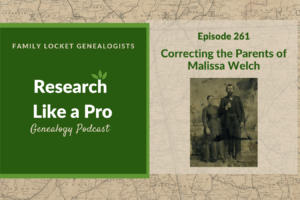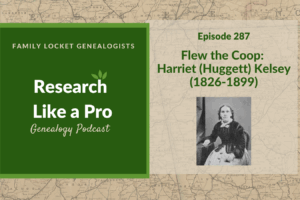
Do you have an ancestor who died fairly young? Have you discovered their story? My great-grandmother, Mary Margaret (Peterson) Creer, died in her mid-50s. Her daughter, Florence Matilda (Creer) Kelsey, my grandmother, was expecting her fifth child when the family gathered and took their last photo together in 1925. Mary would miss meeting most of her grandchildren and seeing her youngest children grow up.
Although I never met Mary Margaret, stories and photos shed light on a life that was cut short. I am impressed, though, with all that she accomplished in the face of challenges.

The Creer family: Back row: Florence (my grandmother), Charles, Clarence, Sarah, Elizabeth Ann, Harold, Clara. Front row: Alvera, Mary, Ronald, Lillian, 1925
Beginnings
Mary was born to Danish immigrants on 25 April 1871 in Spanish Fork, Utah. She was the third child of Soren Peterson and Margrethe Mathilde Rigtrup. Her parents had each joined The Church of Jesus Christ of Latter-day Saints in Denmark and emigrated to Utah as young people with their families. They met and married in Spanish Fork in 1867 and started their family. Margarethe’s first daughter, Hannah Matilda, died soon after her birth. She went on to have a son, Charles, and a daughter, Mary Margaret, followed by seven more children. Mary must have been a large help to her mother as the oldest daughter.
Sadly, Margarethe died on 11 May 1886 after giving birth to her tenth child, Florence Irene. Mary was fifteen at the time. She likely helped care for her seven younger siblings. When baby Florence Irene died on 4 September 1886, at only five months old, Mary must have been heartbroken. To have lost her mother and youngest sister when she herself was only a young woman would have been very difficult. Mary’s father, Soren, married again in 1889, so the new wife, Mary Frances, would have taken over the housekeeping duties, and Mary Margaret was free to start her own family.
Marriage and Family
Mary and Charles Cannon Creer married on 25 March 1892 in the beautiful Manti Temple. A wedding reception was held in their honor in the white brick house Charles had built for his bride. Located across from the city park in Spanish Fork, the two-story home had a living room, kitchen, and bedroom downstairs and two bedrooms upstairs. The house was enlarged several years later to accommodate their growing family. Mary had eleven children, all born in the white brick house. Mary lost two of the children at birth, but she was able to raise nine of them. She named her first child, Florence Matilda, after her oldest and youngest sisters, who both died as babies.
The Accident
Mary’s daughter Clara wrote the following about the accident that shortened Mary’s life.1
After Mother and Dad had been married for about 15 years she met with a severe accident which rendered her an invalid for the rest of her life. I was about 6 years old when this accident happened, but I remember it well. Father had a dry farm in Thistle Valley. He had taken the family up to the little cabin he had built on the farm. It was only about 15 miles from home but it took a buggy and a wagon to transport us to and from. Mother became anxious to go home. By the time we had packed up a storm was approaching. The house was on the top of a hill and we had to go down a steep dugway to get to the main road. Mother decided to walk down the hill. She took two of the children with her and took a short cut. A stiff wind was behind her. She lost her balance and fell. She broke her kneecap. In those days, the Doctors in our town were not too experienced in treating this kind of a wound. They treated her improperly and bone in her leg decayed. She was taken to a bone specialist in Salt Lake who operated on her three times but were unable to correct the situation. She suffered with this pain for 16 years before she died.
Talents
Clara also wrote about her mother’s talents in music and storytelling. She wrote:
Mary had two exceptional talents. She was very musical and a great story teller. Her father, Soren Peterson, bought her one of the first organs to Spanish Fork. When she was very young, she showed unusual musical ability and became the organist of several organizations in the church. She was often the accompanist for the leading vocalist in the city. Her instrument was the organ but she could play the piano well whenever she could.
Even though Charles was a farmer, he was the private secretary to his father, William, when he was in the state legislature. His business took him to Salt Lake City once in awhile. He kept his business affairs to himself but he loved to surprise the family with unusual gifts when he came home. On one occasion he was so excited about a special piece of freight that was coming on the next train. It was a gift and a surprise for Mary. When it arrived it was in a large crate. The family was all in awe when they saw the biggest and most elegant upright piano they had ever seen. It didn’t take Mary long to sit down at the piano and play some of the greatest music they had ever heard. Charles surprise gift was complete and Mary’s joy was immeasurable.
Most of the girls learned to play the piano. Charles brought home a mandolin for Mary to learn to play. This also gave her a lot of enjoyment. From then on, even during the sad times, there was music in the home. Many times she would tell a story with a musical accompaniment. The children could not get enough of this kind of entertainment. As soon as she would finish a piece, they would eagerly say play it again, play it again.
She was a great story teller. She could read a story and retell it in a more interesting way than the original version. She was very creative and had a great imagination. Occasionally she would tell a story and accompany herself on the piano.
Legacy

Creer sisters: Lillian, Sarah Jane, Clara, Florence, Alvera, Elizabeth Ann
Mary left a legacy in my family. My grandmother, Florence, learned to sew from Mary, who dressed her six girls impeccably, usually in matching dresses for each Easter, Christmas, and 4th of July. Florence sewed all of her three daughter’s clothes and continued sewing throughout her life – quilts, pillows, nightgowns for her granddaughters, and more.
My mother also sewed matching dresses for my sister and me, and I continued the tradition by sewing matching dresses for my daughters. Music was a large part of the Creer home – I inherited Mary’s musical talent for playing the piano and organ. Although my grandmother never played the piano, she loved hearing me play.
When I married, my great-aunt Clara, known to the family as Aunt Cal, gave me the glass compote that had belonged to Mary. I wish I knew more of the compote’s story – perhaps it was a wedding gift or another surprise brought home by Charles. I wrote about it in my blog post Honor Your Heritage with Heirlooms.
This precious heirloom connects me to the great-grandmother I never knew, and someday I’ll pass it on to one of my granddaughters – connecting her to her ancestor.
Addendum – 13 April 2023
Thanks to reader, Kim Kinsey, who has experience in researching china, crystal, and silver, I now have more information on the compote! Kim found that the compote is the “Aurora Clear” pattern, which was made by Brilliant Glass Work, circa 1888. Clicking on the Aurora pattern, I scrolled through the images and found a footed bowl that looks almost identical to the compote.
Kim noted that the company went bankrupt in 1892, and the molds went to the Huntington Glass Company. The website, Replacement.com dates this pattern as made between 1888-1902, so that might include the Huntington years. Based on this information, it looks like the compote very likely could have been a wedding gift in 1892.
Thanks, Kim, for putting your research skills to use in helping me learn more about this family treasure!

Best of luck as you write your ancestor stories!
Sources
- Clara (Creer) Mason, “Memories of Mary Margaret Peterson by Daughter Clara,” Mary Margaret Peterson KWCD-3VK, FamilySearch (https://www.familysearch.org/photos/artifacts/16169729 : accessed 1 April 2023).
















Leave a Reply
Thanks for the note!